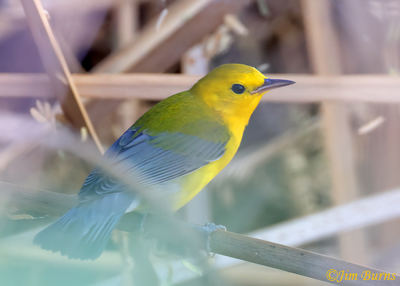
As I reflected back on that week, I began to realize that asking myself how it happened or where my planning went wrong was not the important question. Birders can’t control birds’ movements, and we can’t anticipate or predict what we can’t control. To me the more interesting issue by far was why did I chase unsuccessfully three days in a row and why did I even go out birding the fourth day, or the following week. What keeps avid birders going in the face of disappointment?
As you might suspect, the answer to this question was presented to me on that fourth day. Twice! First literally and then, oddly enough, scientifically, only an hour later. I had set out early on the fourth day to look for the Virginia’s Warbler someone had posted at the Gilbert Water Ranch. Virginia’s are a rather common nesting mountain species in Arizona, but to date I have only two decent images. I searched for a couple hours or so along a mesquite lined path where it had been reported, but had no luck.
Muttering to myself, I sat down on a bench looking into a dense tangle of eight foot high reeds growing out of a small creek next to the path. Suddenly a warbler sized bird flipped down from the tree above me and dropped into the reeds. All I saw was a flash of yellow, certainly not a Virginia’s but possibly any of the several yellowish warblers I had already seen that morning—Yellow, Wilson’s, McGillivray’s, and Orange-crowned. But it somehow seemed a little larger and a little brighter than all of them!
Adrenaline pumping, I fortuitously raised the camera first, not the binoculars. What I saw, partially occluded of course in the tangle of mesquite branches and vegetation, was a hitherto unreported male Prothonotary Warbler, not an unexpected fall migrant through the desert, but certainly far less common than three of the four vagrants I had unsuccessfully chased all week.
Call it luck. Call it karma. Call it what you will, but here was the golden nugget, the explanation for why birders keep on keeping on, the metaphorical answer to what I was doing out here on the fourth day of a very bad week. The high birders seek and often find is fueled by the anticipation we feel as we research and plan our odysseys through the natural world. And then, not thirty yards up the path as I floated out on my Prothonotary high, was one of the “Mental Health Tip” signposts the city of Gilbert has placed throughout the water ranch--
Dr. Kimberly Diggles is a PhD mental health therapist based in California. I don’t know whether she’s a birder, and I’ve never read any of her blogs or articles, but she had me at “anticipation.” I’ve been out with the camera and binoculars every day since I stumbled onto the Prothonotary Warbler. I haven’t seen anything but the same old, same old common Valley species, but I can’t wait to get out there again tomorrow. Yeah, and I feel happy.LOOK FORWARD TO SOMETHING—“The very idea of anticipating something good can physically change your brain chemistry so you feel happy.”—Kimberly Diggles.
